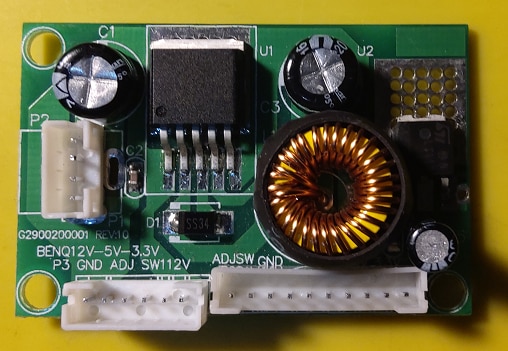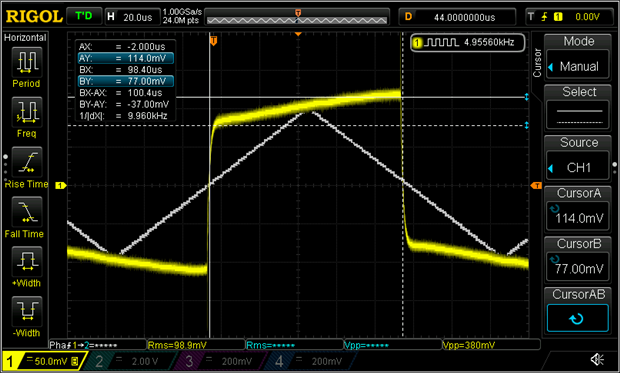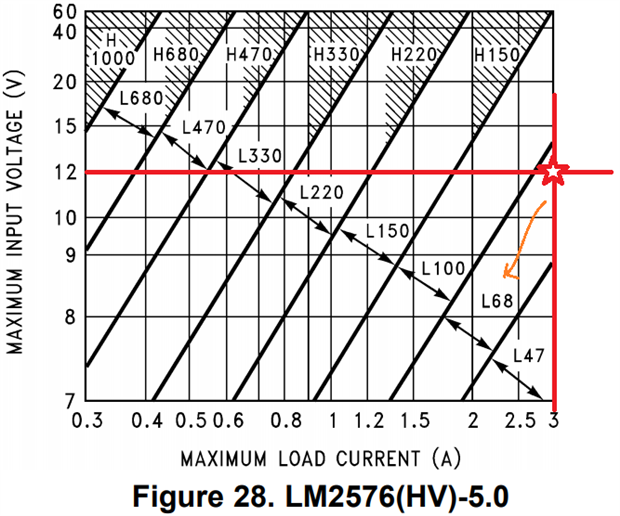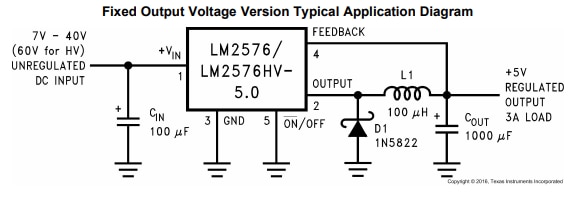There are affordable switch mode DC converters available.
One that you see often is this Benq 12 V to 5V converter.
I can find info on all components, except the inductor. And I don't have an inductance meter.
There are several other ways to measure inductance. In this exercise I'm using the method with triangle waveform as described on meettechniek.info.
Ingredients:
- the inductor, desoldered
- a function generator with triangle waveform option
- an oscilloscope
The setup is straightforward.
Set the generator to 50 Ohm and tune it in to a reasonable frequency. I set it at 10 kHz (my inductor is made for the kHz range).
Put the output over the inductor, and the oscilloscope probes.
Then push the voltage of the generator as high as possible, while the waveform doesn't start to show saturation. See the yellow waveform below for an impression.
Then change the frequency so that the voltage drops as low as your oscilloscope can deal with. In my case, I turned it down to 5 kHz.
Then start measuring.
VR: delta of the ramp. I used the delta of horizontal cursors for that: 32 mV
VL: between 0 and halfway the ramp: 95.5 mV.
t: time of the ramp. I used the delta of the vertical cursor for that (and it's half the time of one cycle too): 100 µs.
Ri: impedance of the generator. We had set it to 50 Ohm.
Vg: peak-to-peak output of the generator. Unplug the inductor and measure it with the oscilloscope: 8.16 V.
(I also captured it with the white REF signal but note that it's not at the right horizontal location. The peaks should be at the same spot as the peaks in the yellow trace)
... and Calculate the Inductance
(the formula images are from the meettechniek.info site)
= 8.16 V / 50 Ohm = 0.16 A
= 0.095 V * (100 µs / 0.16 A)
= 0.0000594 H = 59 µH
In the common inductor tolerance series, that would most likely be a 68 µH one.
Validate with the Switch Mode IC specs
Let's check this off with the specs of the LM2576 5V IC that's used in this circuit.
The PCB has an input spec of 12 V. It claims to switch up to 3 A (I found one website that indicated this - most don't claim current).
On the Inductor Select graph, this brings us here:
image source: TI LM2576 datasheet
That is a match: 68 µH. The expected inductor is used on the PCB.
And the triangle waveform method turned out to be a valid way to get at the inductance of a coil.
The whole circuit is exactly the typical application schematic from TI, adjusted for the 12 V input and 3 A output.
image source: TI LM2576 datasheet
Input and output caps are 220 µF.
The Schottky diode is a On Semiconductor SS34.
Link to other magnetics related posts.







Top Comments
-

Jan Cumps
-
Cancel
-
Vote Up
+4
Vote Down
-
-
Sign in to reply
-
More
-
Cancel
-

shabaz
in reply to Jan Cumps
-
Cancel
-
Vote Up
+5
Vote Down
-
-
Sign in to reply
-
More
-
Cancel
-

Jan Cumps
in reply to shabaz
-
Cancel
-
Vote Up
+3
Vote Down
-
-
Sign in to reply
-
More
-
Cancel
-

shabaz
in reply to Jan Cumps
-
Cancel
-
Vote Up
+3
Vote Down
-
-
Sign in to reply
-
More
-
Cancel
-

three-phase
in reply to Jan Cumps
-
Cancel
-
Vote Up
+2
Vote Down
-
-
Sign in to reply
-
More
-
Cancel
-

Jan Cumps
in reply to three-phase
-
Cancel
-
Vote Up
+2
Vote Down
-
-
Sign in to reply
-
More
-
Cancel
-

Jan Cumps
in reply to Jan Cumps
-
Cancel
-
Vote Up
+2
Vote Down
-
-
Sign in to reply
-
More
-
Cancel
Comment-

Jan Cumps
in reply to Jan Cumps
-
Cancel
-
Vote Up
+2
Vote Down
-
-
Sign in to reply
-
More
-
Cancel
Children